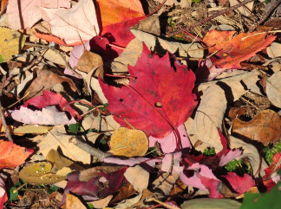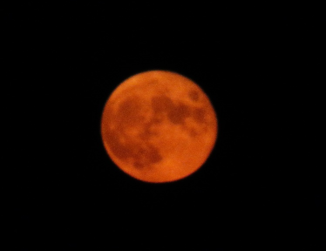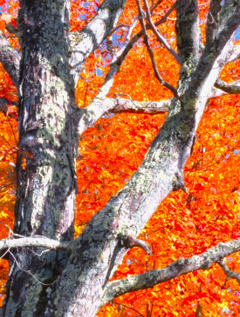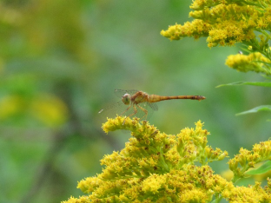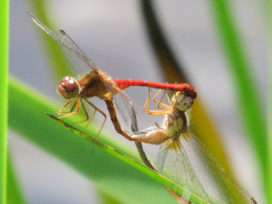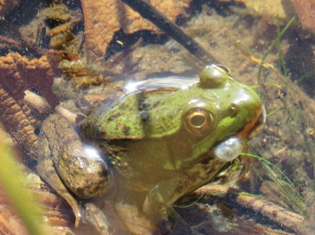Phenological Phacts and Photos w/ Carl Martland / October 2023
The Other Colors
Phenology – “a branch of science concerned with the relationship between climate and periodic biological phenomena (as the migration of birds or the flowering and fruiting of plants).”
Fall Foliage
Last year, at the end of a long, dry summer, I often wondered “Will the foliage be any good this year?” Probably not, I thought, remembering the ugly, blackened maple leaves that littered our driveway at the height of the drought. But I was wrong, the foliage colors were great, and the hillsides of Sugar Hill continued their brazen display through the middle of October.
October 22, 2022, 65 degrees, partly cloudy, warm & wonderful! The high hills are devoid of color, but the local hills still have a lot of yellow and orange and a tiny bit of red; the larches are turning. …
Tourists driving through the notches would have been disappointed by the lack of color on the peaks, and those on the tour buses would have hoped for more reds, but those lucky enough to live in the North Country simply appreciated the lingering yellows and oranges.
My journal entry for October 22nd continues:
… On the dam, I found three meadowhawks, two bluets, and one bee, but no butterflies.
In other words, even at the end of October, I was out looking for the insects and flowers that still brightened my daily walks along the dam and through the meadows.
Whatever the status of the foliage seen across the mountain ranges, we can take the time to enjoy what may be called “the other colors” that can be found right at our footsteps and all around us. Look closely and you will see all the colors of the rainbow.
Red Maples
Though the red maples have a few days of glory at the end of September, their fallen leaves brighten the trails for a few more weeks. Red maples provide a blaze of glory in early fall, and individual leaves merit our attention long afterwards.
September 29, 2015. A brilliant red maple!
October 9, 2015. A fallen maple leaf creates a spot of color on my trail through the Back 4.
1 Photos and text by Carl D. Martland, founding member of ACT, long-time resident of Sugar Hill, and author of Sugar Hill Days: What’s Happening in the Fields, Wetlands, and Forests of a Small New Hampshire Town on the Western Edge of the White Mountain. Quotations from his book and his journals indicate the dates of and the situations depicted in the photos.
Orange Moon
Not all the “other colors” are in the trees or on the ground. If we’re lucky, the skies may be clear when the harvest moon rises above the mountains, which was the case last year (and which may be the case in about two hours, since I’m writing this on September 28th, the night of the harvest moon in 2023.)
September 10, 2022. The Harvest Moon rises, an orange orb above the Kinsmans.
Of courses, there are other glimpses of orange worth a photo just as exhilarating as the ones that captured the orange moon or the entire hillside of Sugar Hill.
October 15, 2022. The afternoon sun highlighted the remaining orange leaves along Pearl Lake Road, an especially captivating sight when viewed through the silvered limbs of the large maple at the corner of Post and Pearl Lake Roads.
Yellow-Legged Meadowhawk
Meadowhawks are the little red dragonflies that emerge from small ponds in late summer and frolic around any body of water through the beginning of October. Several species are common in our region, and unlike most insects, they are each aptly named for their distinguishing characteristic. The white-faced meadowhawk is the first to arrive in early August, and it is the most numerous around our pond. The yellow-legged meadowhawk arrives in mid-August, while the less common cherry-faced and saffron-winged meadowhawks often wait until mid-September. They all love to land on goldenrod and cattails, often forming a wheel, a contorted position that enables a pair to fertilize her eggs.
August 18, 2016. This juvenile yellow-legged meadowhawk was one of the first I’ve seen this year.
September 19, 2018. A pair of yellow-legged meadowhawks formed a wheel. Soon afterwards, they flew over to the pond to lay her eggs.
Green Frog
Green frogs begin their life as tadpoles, and they spend much of their early days under the ice, waiting along with us for the end of the long winter. It is the end of the summer, when they are more than a year old, before they are finally ready to give up their carefree swimming with their buddies and settle down to a solemn, solitary life by the side of the pond. In late summer and early fall, I sometimes find a dozen or more of them sitting along the shore in an opening amidst the reeds. Usually, I am more interested in the dragonflies, because these frogs almost never move.
September 24, 2015. There are still some dragonflies (variable darners and meadowhawks) and damsel flies pairing off. Recently, I’ve seen quite a few small green frogs sunning at the edge of the pond.
Apparently, these small green frogs are also interested in the meadowhawks, but not from my aesthetic or phenological perspectives:
October 6, 2017, 60 degrees, cloudy, still, 330pm. A green frog sat motionless at the water’s edge at a place where meadowhawks were flying in and out, up and down. I focused my camera, but before I could snap a picture, the small frog leaped straight up, trying to snag a meadowhawk that fortunately (for the dragonfly) did not land on the bit of reed that was two inches above the frog. I’ve seen frogs do this before, sometimes successfully, but very infrequently, maybe just a dozen times in 20 years of watching. They must be able to get plenty to eat by sitting still and letting dinner come to them.
October 5, 2017. I took a photo of one of the small green frogs sitting patiently by the edge of the pond. I can’t tell if it was eating something or if it just had an air bubble at the side of its mouth.
Bluebirds
By early October, the fall migration is well underway, and we’re likely to see flickers, bluebirds and a half dozen or more other birds on the lawn, over the meadows, or by the pond.
October 9, 2020, 34 degrees, 930-1030am. A pair of woodcock were feeding in the back lawn, staying in the shade on frost-bejeweled grass. In the movies I took while listening to Patsy Cline, they seemed to bob and bounce in time with the music. I also took a movie of a yellow-bellied sapsucker in the big willow, as well as pictures of the frost coating the wildflowers in the Upper Meadow. In the afternoon, a yellow-rumped warbler, a pine siskin, and a half dozen robins simultaneously foraged across the front yard.
Nancy loves to see the little flocks of flickers when they stop by for a fall forage, but I most enjoy seeing the return of the bluebirds. Although bluebirds were common where I grew up in Rhode Island, we seldom if ever saw them when we lived in Boston. Now a pair often nests in what we call the “Front House,” and others stop by in small groups as they head south for the winter.
October 9, 2020, 2pm.
In the afternoon, after it had warmed up, a half dozen bluebirds enjoyed the bird bath and inspected the “Front House.”
Purple Gentians
Bottle gentians bloom in mid-September, a time when asters and goldenrods dominate the fields and most other wildflowers have gone to seed. Sometimes you can find several clumps beside a rail trail or along a trail made by deer or bears crossing through a field.
September 13, 2014. Gentians bloom in small clumps atop stalks that rise a foot or two off the ground.
I think deer or bears nip these lovely blossoms as a little treat as they prepare for the winter by eating bushels of apples. After finishing off the gentians with a few quick bites, they amble on toward the apple trees.
September 12, 2007 64 degrees, partly cloudy. At 3pm, the fields under the power lines were bright with fall colors: asters (white and light violet), goldenrod, red leaves on small trees, and bronzed ferns. … About 25 bottle gentians were in peak bloom near the end of the path.
September 18, 2007. When I found bear scat under the power lines near where I had seen the gentians last week, I suspected that the flowers had been planted by bears or other animals using this trail.
Since my discovery of gentians under the power lines back in 2007, I try to remember to look for them soon after Labor Day. For a while, we had some right by our pond:
September 14, 2013. For several years, we had some nice clumps of gentians next to the pond by Larch Meadow, but no longer. Since we have evidence of bears using my trail along the pond, perhaps they were eating the flowers and destroying the plants.
Although I miss having gentians by the pond, I have enjoyed finding a great many new clumps along some of my other trails:
September 13, 2019, 66 degrees, breeze, all sun! I followed my old Creamery Pond trail down from Pearl Lake Road through the woods to the brook, where I saw a few white-faced meadowhawks and many crickets and grasshoppers. Coming out to the fields under the power lines, I didn’t see any butterflies or any more dragonflies, but I did find a nice batch of gentians and some pretty golden ferns. Under the power lines on the other side of the road, I saw two monarchs and a mosaic darner flying near more golden ferns and an even larger batch of gentians.
Look for the “Other Colors”
I could go on a great length, but the point I am trying to make is simple. The peak foliage only lasts a week or so, but you can get nearly as much enjoyment from the “other colors” for pretty much all of September and October. As I said in the introduction, “Look closely, and you will see all the colors of the rainbow.”
Of course, I can’t deny the appeal of the mountainsides of fall foliage that pulls the leaf peepers up I93. After all, when autumn leaves begin to call,
EVERYONE LONGS TO BE IN THE NORTH COUNTRY!
October 5, 2009. The end of a brilliant rainbow seemed to lie somewhere in the field on the other side of Post Road. I didn’t check for the pot of gold, figuring that one of the neighbors was already out there looking for it.


